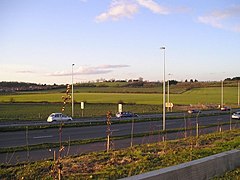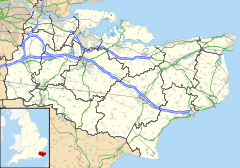Chattenden
| Chattenden | |
|---|---|
 View of Chattenden from the A228 | |
Location within Kent | |
| OS grid reference | TQ758722 |
| Civil parish | |
| Unitary authority | |
| Ceremonial county | |
| Region | |
| Country | England |
| Sovereign state | United Kingdom |
| Post town | ROCHESTER |
| Postcode district | ME3 |
| Dialling code | 01634 |
| Police | Kent |
| Fire | Kent |
| Ambulance | South East Coast |
| UK Parliament | |
Chattenden is a village within the civil parish of Hoo, which is within the unitary authority of Medway, Kent, England. It was, until 1998,[1] part of Kent and is still ceremonially associated via the Lieutenancies Act.[2] The A228 goes through the village.
Etymology
[edit]The first datable attestation of the name Chattenden is in 1281, as Chattindone, alongside other early spellings such as Chetindunam, Chatendune, and Chetyndone. Scholars agree that the final syllable comes from the Old English word dūn ("hill"), but the origin of the rest of the name is debated. A personal name, *Ceatta, followed by the Old English place-name-forming suffix -ing, has been suggested, in which case the name meant "hill at Ceatta's place". Since the people of nearby Chatham were known as the Cēthǣmas, *Cēthǣmadūn ("the hill of the people of Chatham") is possible.[3] But 21st Century scholars have tended to think that the initial element of the word (as in Chatham itself) is the Common Brittonic word whose modern Welsh reflex is coed ("woodland"), referring to Great Chattenden Wood, followed by Old English ing. This wood-name may also be attested in the names of Upchat Road and Lochat Road. If so, the Old English name meant "hill at [the place called] Chat".[4][5]: 316 [6]
Geography and ecology
[edit]Turning left on the A228 on the brow of Four Elms Hill, leads onto Kitchener Road, that eventually leads itself to Chattenden Woods and Lodge Hill, designated as an SSSI, due to the diversity of insects, birds, plants and trees found there. To the south of Chattenden is Towerhill Wood, also known as Coxham Wood, with has Public Footpaths that lead into Lower Upnor, where the Arethusa Venture Centre and the Medway Yacht Club (MYC) are located. Along the A228, (which becomes the Ratcliffe Highway in Chattenden), was once a pub known as 'The Old George' that was situated just before the Jet Petrol Station. The Old George was constructed from February 1847 to November 1847.
Military History
[edit]The Royal Navy built an ordnance depot along Beacon Hill Lane, near to Four Elms Hill, which stored gunpowder and other supplies near to the Royal Naval Barracks. Additionally, the Royal Navy installed a British Military Narrow-Gauge Railway, anti-aircraft gun batteries, and a shell store. Construction of the ordnance depot began in October 1872 and was completed in December 1872. The various clerical and residential buildings of the Royal Naval Barracks next to Beacon Hill Lane were built from April 1875 to June 1875, and the War Office also built five magazines on a hillside overlooking the River Medway at Chattenden during the same months in 1875. This facility expanded and a nearby site at Lodge Hill was established in 1899. Most of the designated sites, which became known as Chattenden and Lodge Hill Military Camps, were put up for sale in 2016 by Homes England, which is part of the Ministry of Housing, Communities and Local Government.[7] However, the land on both sides of Beacon Hill Lane is still owned by the Ministry of Defence (United Kingdom). From August 1940 to September 1940, the War Office built a Royal Navy Wireless Station adjacent to Beacon Hill Lane and a concrete Blockhouse or Pillbox was built on an artificially constructed mound at the top end of Beacon Hill Lane, which also functioned as an observation platform near to the River Medway.
See also
[edit]Notes
[edit]References
[edit]- ^ "Medway Council – Local history: Medway in the 20th century 1901 – 2000". 2009. Archived from the original on 9 March 2009. Retrieved 9 June 2012.
- ^ "Lieutenancies Act 1997". legislation.gov.uk. 2012. Retrieved 9 June 2012.
- ^ Watts, Victor, ed. (2004). The Cambridge Dictionary of English Place-Names, Based on the Collections of the English Place Name Society (EPNS) at the University of Nottingham. Cambridge: Cambridge University Press. ISBN 9780521168557., s.v. Chattenden.
- ^ The Place Names Of Kent, Judith Glover, 1976, Batsford. ISBN 0-905270-61-4
- ^ Coates, Richard; Breeze, Andrew (2000). Celtic Voices, English Places: Studies of the Celtic Impact on Place-Names in Britain. Stamford: Tyas. ISBN 1900289415..
- ^ Stoodley, Nick; Cosh, Stephen R. (2021). The Romano-British villa and Anglo-Saxon cemetery at Eccles, Kent: a summary of the excavations by Alexander Peter Detsicas with a consideration of the archaeological, historical and linguistic content. Oxford (GB): Archaeopress Publishing. ISBN 978-1-78969-587-8., p. 209.
- ^ "MoD to sell Lodge Hill near Chattenden". Kent Business. Retrieved 3 September 2016.
Sources
[edit]- Heritage, English; Saunders, A. D. (1 January 1985). Upnor Castle: Kent. English Heritage. ISBN 978-1-85074-039-1.

